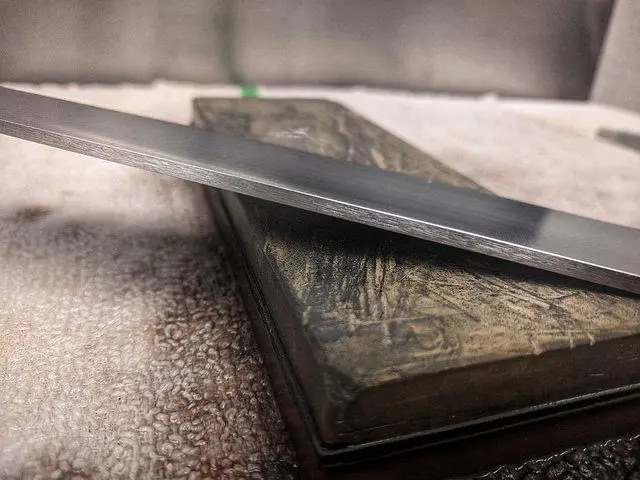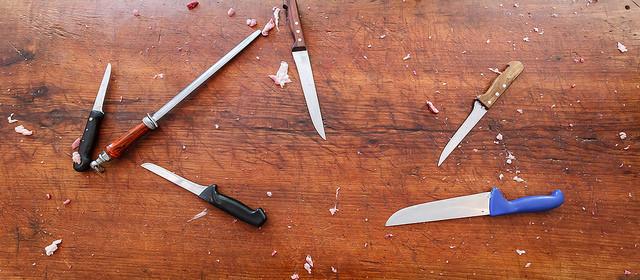(This site is reader-supported. When you buy something using retail links on our articles, we may earn a small commission. As an Amazon Associate I earn from qualifying purchases.)
Being light, sharp, and rustproof, a ceramic knife or Zirconia is widely used as the viable alternative to a steel kitchen knife. This is because it is made using zirconium dioxide, a build material that is stronger than steel. As a result, ceramic knives tend to hold their edge for a longer time than a steel knife.
This has perhaps made the manufacturers promote their ceramic knives with an unbelievable marketing promise of no dulling at all. However, this promise is not to be believed literally, as it is a myth. It is a common misconception that these knives never get dull.
This is because even ceramic knives are brittle. Just because they are made up of sturdier material does not mean that they are fully resistant to dullness. The blades of ceramic knives are subject to dullness.
The only difference, when compared to other knives, is that the blades of ceramic knives get dull after a long time. If you take good care of these knives and use then only on items for which they are made, they will function for years without being dull.
So, if you now have a dull ceramic knife, it is obvious for you to find and know how to sharpen a ceramic knife. Although it is not as easy as sharpening a steel knife, sharpening a ceramic knife is also not impossible.

When it comes to sharpening, ceramic knives need special attention; just any old or manual sharpener will not do. In fact, there are several methods to sharpen these knives, which give you the freedom of selecting the most suitable one.
For properly preparing yourself for sharpening the blades of ceramic knives, continue reading the remaining post. It reveals all the basics of sharpening along with the steps to make your ceramic knife razor-sharp again.
Is It Possible to Smoothly Sharpen a Ceramic Knife to Restore the Razor-like Sharpness of its Blade?
Yes, it is! It is wrong to think that the ceramic knives will never require sharpening. With enough abuse, their blades can get dull within an estimated period of half a year.
If you do not want to replace with a new knife, you have no option but to sharpen the blades. If you do not sharpen, the risk of chipping increases due to which the blades become further dull.
The good news is that you do not sharpen the ceramic knives as frequently as the steel knives. After how long sharpening is required depends on your usage. It may work well for years without sharpening.
On the flip side, it is tough and/or costly to sharpen this knife. To reduce the difficulty level, you may opt to hire a professional service that can prove to be costly. On the other hand, if you wish to save money and face the sharpening difficulty, you need to be very careful and apply all the dos and don’ts.
You also need to identify and use the best sharpening system for your ceramic knife. While there are many sharpeners thronging the market, you just cannot pick and use any of them for your knife. This is because not all sharpeners are effective on ceramic blades.
If you are sharpening a ceramic knife for the first time, it is wise to not take it as a DIY task. The next section explains why. If you still want to take it up, first try experimenting with an old knife for learning how to sharpen a ceramic knife.
A Tricky Job to Sharpen Ceramic Knives
Yes, it is tricky to sharpen a ceramic knife. The problem is the incredible brittleness of this knife that otherwise appears and feels great in your hand. This means that it is easier to break this knife than a steel knife.
Keeping this in mind, learning how to sharpen a ceramic knife requires extreme caution of not applying too much pressure laterally on the blade. If applied, the blade will break into two pieces. The good news is that this is the only thing to take care of while sharpening ceramic.
This rule is especially worth remembering if you have sharpened blades of other knives not made of ceramic. This is because you are likely to look for some coil or feedback as experienced while sharpening a steel knife in the past.
Just as glass, ceramic does not come up with any spring or feedback level at the time of applying pressure. Unlike sharpening steel, there is no risk of the burr on your ceramic knife. This is because ceramic is not ductile. Thus, the sharpness of its edge depends on the edge’s final grit as well as upon the precision of your movements.
Tools Required for Sharpening a Ceramic Knife
Different tools are available for making the blade of your ceramic knife razor-sharp. Some of them are diamond sharpening rod, diamond sharpener stone, diamond wheel sharpener, whetstones, ceramic knife sharpener system, sandpaper, and water for lubrication.
When it is the matter of choosing sharpening tools for your knife made using ceramic, it is wise to go with anything diamond. Believe it or not, diamond stones and sharpeners are worthy of your time and money. This is because diamond is the only material that is stronger or harder than ceramic.
Technically, you can go with the types of knife sharpening tools such as whetstones and sandpaper. However, they do not surpass the diamond sharpeners in terms of performance and the desired sharpening impact.
It takes less effort to apply diamonds on the edge of a ceramic knife than the other materials available. You are also not lured to accelerate the process by applying more pressure. Here, it is the game of quickness and efficiency.
The Most Common Myth Regarding Ceramic Knife Sharpeners
Many knife owners tend to invest in a ceramic knife sharpener with a belief that they are exclusively made for sharpening ceramic knives. Well, this belief is a myth. As a fact, these sharpeners are mostly the ones with sharpening abrasives. Well, these abrasives are made using ceramic.
So, this does not mean they are made for ceramic knives. Rather, they are ideal for sharpening steel knives. Thus, while looking for a ceramic knife sharpener, ensure that the sharpener is made for ceramic knives, and not made of ceramic.
Different Ways of Sharpening Ceramic Knives
Below are the different ways, methods, or techniques to try to know how to sharpen a ceramic knife:
Using Diamond Stones
A sharpening stone is a good tool for ceramic knife sharpening. However, you will end up working harder than an electric sharpener if the blade is special. On the motivational side, stones are more economical than electric sharpeners.
Using a diamond stone is the traditional way of making a ceramic knife sharp. For a DIY person like you, it will always satisfy you. While you can use sandpaper, diamond stones are smarter because of their build quality.
To get started, you need 200 grit, 600 grit, 1000 grit, and 1500 grit diamond stones. Yes, you need these four stones. For sharpening, you only must pass each of these stones on each side of the blade. If the blade has large chips, do sharpen it using the 200-grit stone.
You can skip this step if the dullness is not that severe. You can now sharpen the blade using the remaining three stones. Rubbing the blade against them will make it sharp, which is what you had at the time of buying it.
You will also come across whetstones with diamond surfaces. They too belong to the category of diamond stones. Some of the best whetstones come with three stones of the diamond, each with a distinct surface: coarse for handling a dull edge, fine for a sharp edge, and extra-fine for refining the edge. Some stones just come with #600 grit for ensuring an ideal sharpening performance.
To get started with cut-resistant gloves, place your diamond whetstone on a folded towel acting as an anchor. Then, place the blade between 18-20 degrees for getting a professional outcome. Now, start sharpening by striking the full blade against the stone for six times. Now, repeat the steps for the other blade side.
Finally, clean the blade using a towel with hands still covered by the protective gloves. Many online articles will recommend soaking the stone in water for 45 minutes to get a better sharpening outcome. You can even use oil over the stone for easier sharpening.
| Image | Title | Price | Buy |
|---|---|---|---|
 Top
Top | Trend DWS/CP8/FC 8-Inch Double-Sided Professional Diamond Bench Stone with Clearance Channels, Fine/Coarse | Check Price on Amazon | |
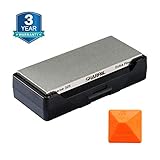 Top
Top | SHARPAL 156N Diamond Whetstone Knife Sharpener with Storage Base | 2 Side Grit Coarse 325 / Extra Fine 1200 | Check Price on Amazon | |
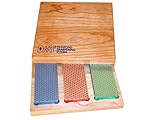 Top
Top | DMT W6EFC Three 6-Inch Diamond Whetstone Models in Hard Wood Box | Check Price on Amazon | |
Top Top
Top | Sharp Pebble Premium Whetstone Knife Sharpening Stone 2 Side Grit 1000/6000 Waterstone | Check Price on Amazon | |
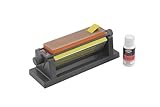 Top
Top | Smith's 50448 6-Inch Diamond Tri-Hone Sharpener | Check Price on Amazon | |
 Top
Top | Jewboer Double Sided Diamond Sharpening Stone (400/1000 grit) | Check Price on Amazon |
Using Sharpening Rods
There are manual diamond rods, but they can be less convenient than the electric sharpeners. However, a few rods can efficiently sharpen your knife. If you want to try a rod, ensure that it is made using diamond steel to get a sharp edge.
It is very easy to sharpen a ceramic knife using a sharpening rod. Just hold the rod horizontally or vertically and rub the blade against it three times. Repeat the same for the other side of the blade. That’s it! Do wear cut-resistant gloves while doing this task. Finally, wipe the blade so that no metal fillings are left.
| Image | Title | Price | Amazon Page |
|---|---|---|---|
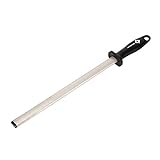 Top
Top | Kota Japan 12 in. Diamond Carbon Steel Professional Knife Sharpener Rod | Check Price on Amazon | |
Top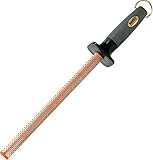 Top
Top | Smith's #3001 10-Inch Oval Diamond Sharpening Rod | Check Price on Amazon | |
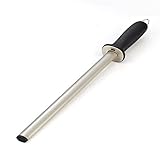 Top
Top | Cooks Standard Diamond Rod Knife Sharpening Steel, 12-Inch/30cm | Check Price on Amazon | |
 Top
Top | Kershaw Ultra-Tek Blade Sharpener (2535); 4-Inch Sharpening Steel | Check Price on Amazon | |
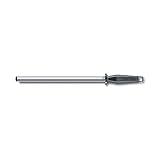 Top
Top | Victorinox 40689 Black Steels - Diamond 12" Oval Hollow Core, Inch, Multi | Check Price on Amazon |
Using an Electric Knife Sharpener
Consider this tool or method for sharpening a ceramic knife quickly and with less hassle. Do you know that such a sharpening system can sharpen any knife? Further, it is quite safe to use if you are a beginner who has no idea of how to deal with a knife.
A good electric sharpener is diamond-abrasive. This is because it is capable of efficiently discarding nicks. Guides also should be there so that the knife does not shake.
As a fact, only a few electric knife sharpeners tend to work well when it comes to sharpening ceramic knives. A big-sized electric sharpener is just not ideal for a ceramic blade.
Thus, before investing in an electric sharpener, it is wise to know the features on offer along with the types of knives it can handle. If you are confused as to which electric sharpener to buy, consider the one that is specially made for a ceramic knife. Such a model will usually have a grinding diamond stone of #600 grade and will be safe to use.
Following are the general steps of sharpening a ceramic knife using an electric sharpener:
- Clean the blade such that no residue is left on it.
- Place the electric sharpener on a flat and steady surface, such as a table.
- Begin with the first sharpening stage. Herein, you place the blade in the sharpener. Usually, electric sharpeners have a dedicated first-stage slot in which you should place the blade. Ensure that the stone and blade touch each other. Once the blade is perfectly placed, turn ON the sharpener and slide the blade tenderly through the slot. Repeat this procedure for both blade sides. Finally, turn OFF the sharpener.
- Start the second sharpening stage. Herein, you just repeat the previous step. Finally, turn OFF the sharpener.
- Repeat 3rd and 4th steps 4-5 times to ensure the desired sharpness.
- Test the sharpness by cutting a tomato. If there is no crushing, it is successful. If cutting is improper, repeat all the previous steps.
- Finally, clean the knife to remove any ceramic dust and avoid food contamination.
| Image | Title | Price | Amazon Page |
|---|---|---|---|
Top Top
Top
Top
Top | Chef’sChoice 1520 AngleSelect Diamond Hone | Check Price on Amazon | |
 Top
Top
Top
Top | Chef’sChoice 15 Trizor XV EdgeSelect | Check Price on Amazon | |
 Top
Top
Top
Top | LINKYO Electric Knife Sharpener | Check Price on Amazon |
Using a Manual Knife Sharpening System Like Work Sharp
Consider manual sharpening systems if you love versatility or if there many ceramic blades in your kitchen, which must be sharpened regularly. The beauty of this sharpener is that you can use it in any kinds of knives, not just ceramic. You can invest in this expensive equipment if you have a lot of knives to sharpen.
These sharpeners tend to look complex and are costly. However, you will not have a hard time using any of them. Surprisingly, they are easy to use.
They can handle many knives for sharpening. You can even sharpen scissors and other kitchen tools using them. This is something that other knife sharpeners cannot do. Due to a small belt and a diamond abrasive coating, these sharpeners give you razor-sharp ceramic knives and other tools.
Just place the abrasive belt on the external guide prior to sharpening a tool. Now, holding the knife in one hand, slide it against the belt for four to six times. If the belt stops working, it is time to use a new belt.
| Image | Title | Price | Buy |
|---|---|---|---|
Top Top
Top | Work Sharp Knife & Tool Sharpener Ken Onion Edition | Check Price on Amazon | |
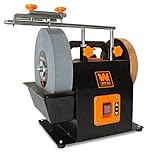 Top
Top | WEN 4270 10-Inch Two-Direction Water Cooled Wet/Dry Sharpening System | Check Price on Amazon | |
 Top
Top | Work Sharp Knife & Tool Sharpener | Check Price on Amazon | |
 Top
Top | Tormek Sharpening System A Complete Water Cooled Sharpener with Hand Tool Sharpening Jigs | Check Price on Amazon |
Conclusion
For a beginner, an electric sharpener is a better option when it comes to how to sharpen a ceramic knife. Stones are better for experienced users. A work sharp knife and tool sharpener is ideal for those having several ceramic knives.

Hi, I am Jay. I am the creator of Knife Guides, your one-stop site for everything related to knives. I am a computer engineer by profession, knife aficionado by passion. Here I work with a group of people who’ve always had a passion for knives and blades. Over the years we’ve kind of become experts and decided to share our knowledge and ideas. I am also an avid hiker and enjoy offshore gamefishing.

